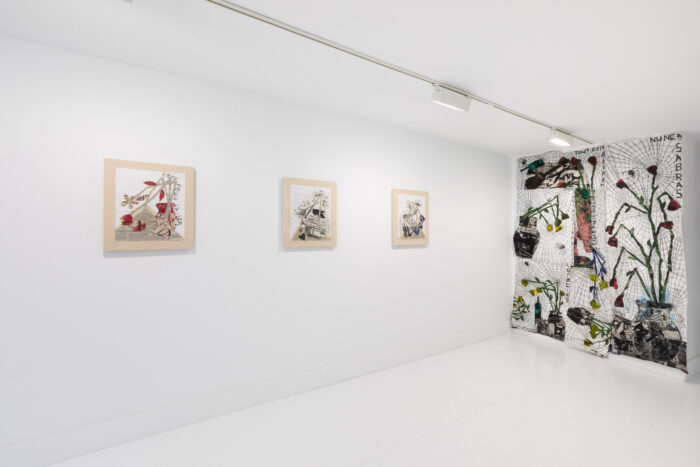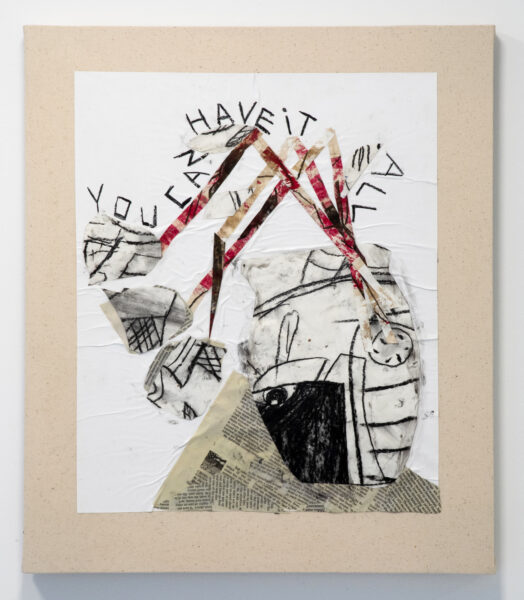
The work of Fernando Pintado, at his solo show “Aqui y Ahora,” is a canvas monument to heartbreak. Displayed along the walls are ten canvases of the same size, depicting jars of drooping roses, broken along the stems to dive downward towards the corners. Graphic and hard-edged, the cutout shapes score the edges between empty space and form. They are breathless in a way that makes Matisse’s cutouts remarkable in their difference- unapologetically lyrical, spacious, buoyant. Where Matisse engages the body and joie de vivre, these vases engage the veins and broken promises. We are trapped with them, pulled into their restriction, to share a poet’s emotional scale in a compressed and shattered space.
The flowers and the jars are cut out of old work; stapled, chopped, and screwed into a somber Romantic shuffle. This kind of defiant and self-destructive act resonates as brave- a lack of fussiness, of self-importance and preservation not afforded to the depressed and earnest. It is painting as visual poetry, an endless moving of canvas and paper fragments like Apollinaire’s Calligrammes; disenchanted in a way that picks up where others left off, a lineage of Infra-Realists and Romantics.

Romanticism is the sleight-of-hand language of the cynic, the clay of the disappointed. It gives the people what they need while camouflaged as something that they want- mixing medicine into the dessert. The present moment to the Romantic requires the enchanting of every day through Surrealism, the introspective fantastic, and the excavation of dreams. Its nature is an impulse of dissatisfaction. The world, as is, leaves much to be desired.
True Romanticism isn’t Fragonard. It’s Blake. It’s Turner. It is Goya. The MacGuffin is the maze of pearls and frills, the Watteau lutes, the shells and capriccio archways, and the swirling taffy of putti. Romanticism wouldn’t exist without disappointment and grief- grief at a better-imagined world that is left impossible to access. Platonic yearning is the itch and Romanticism is the scratch. The devout choose religion, artists choose aesthetics; an act that is inherently resigned. Like Mike Kelley’s romantic janitor, it is the fixed look to the far off distance, mop in hand, standing in the gruesome mess.

Goya was a janitor. Los Desastres de la Guerra was made because someone had to make it. Someone had to look where no one else wanted to. Sick and mostly deaf, he aimed one last kick, that of a dying mule, upwards towards the jaw of the powerful. He took the mop. He asks us all to hurt as he does.
Roberto Bolano’s model for the artist was the detective. The detective, Bolano would explain, is not the smartest or most talented- they are simply the ones who stay in the room, long enough to understand it. Like Kelley, like Goya, Bolano punched the clock and got comfortable in the space others are quick to leave. Pageantry and pablum were intolerable to them. Instead, they sought a camaraderie of shared sadness. They’ve found a kinship of janitors and detectives, of infra-realists. “Hurt with us. Worry with us” they say. Pintado’s work joins this invitation.

“Aqui y Ahora” is a love letter. “Here and now” is not a call for the “presentness” of neo-liberalism, but for the existentialist memento mori. The broken cut out flowers, the sharp edge of affective images, sitting barely ahead of spiderwebs that fracture the surface like grids of broken glass. Space-time is shattering, there are only a few moments left to take the leap together. Where is Goya? Where are the friends when you need them? They exist forever through their hurt.
Notice the small painting “You can have it all,” a monochromatic vase with broken gray flowers, angled down, the only color is found in the blood-red stems. Along the stems is the eponymous line “You can have it all,” but you don’t hear the radio jingle of advertising in this promise. Instead, you hear the Nine Inch Nails lyric resolve itself in your mind. “My empire of dirt. I will let you down.”
I will make you hurt.
Fernando Pintado: Aquí y Ahora at Turn Gallery until February 16, 2020.


Muchas felicidades querido sobrino
Un orgullo saber de ti con esta exposición
Tu obra verdaderamente admirable , interesante , extraordinaria , sorprendente